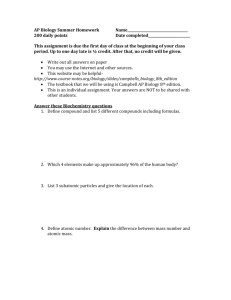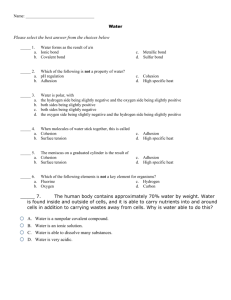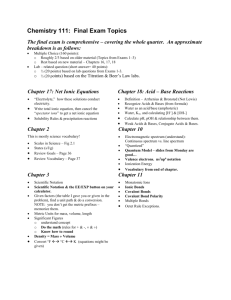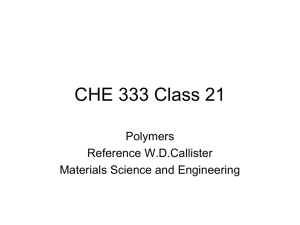Chemistry Final Exam Review # 3
advertisement
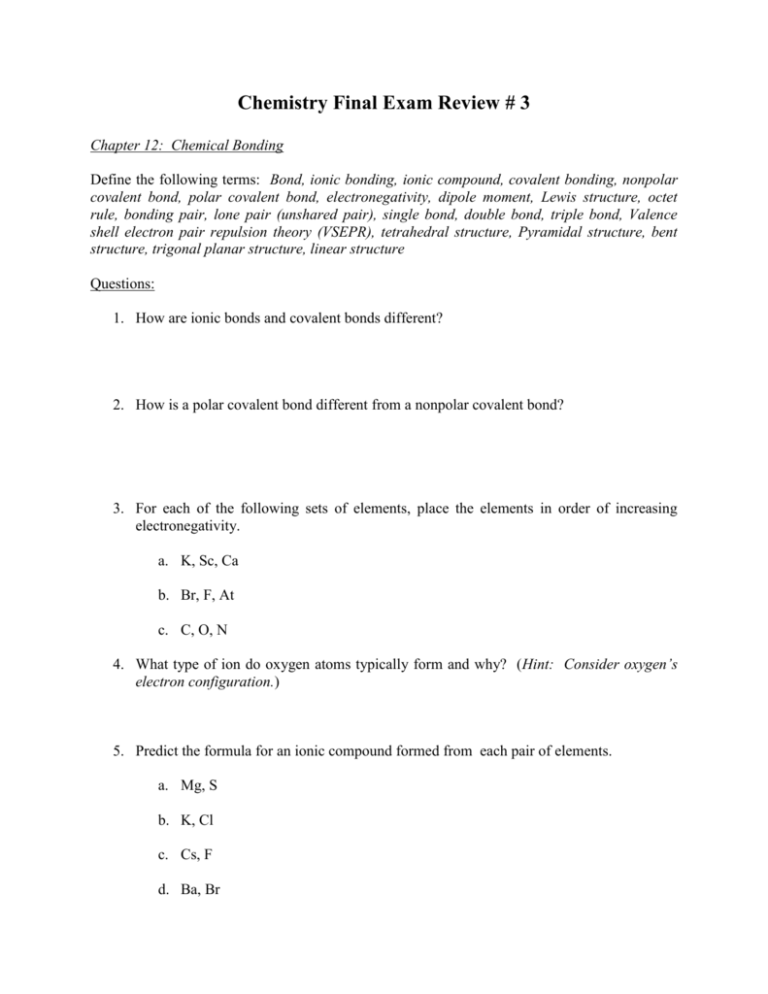
Chemistry Final Exam Review # 3 Chapter 12: Chemical Bonding Define the following terms: Bond, ionic bonding, ionic compound, covalent bonding, nonpolar covalent bond, polar covalent bond, electronegativity, dipole moment, Lewis structure, octet rule, bonding pair, lone pair (unshared pair), single bond, double bond, triple bond, Valence shell electron pair repulsion theory (VSEPR), tetrahedral structure, Pyramidal structure, bent structure, trigonal planar structure, linear structure Questions: 1. How are ionic bonds and covalent bonds different? 2. How is a polar covalent bond different from a nonpolar covalent bond? 3. For each of the following sets of elements, place the elements in order of increasing electronegativity. a. K, Sc, Ca b. Br, F, At c. C, O, N 4. What type of ion do oxygen atoms typically form and why? (Hint: Consider oxygen’s electron configuration.) 5. Predict the formula for an ionic compound formed from each pair of elements. a. Mg, S b. K, Cl c. Cs, F d. Ba, Br 6. For each of the following molecules, draw the Lewis dot structure, list the molecular shape, and give the bond angles. a. CCl4 b. PH3 c. N2 d. SCN-1 (Carbon is the central atom) e. H2S f. C2H2F2 g. CH3OCH3 h. CO2 i. NH4+1 J. H2O Chapter 13: Gases Define the following terms: Pressure, barometer, manometer, standard atmospheric pressure, Kinetic molecular theory, Boyle’s Law, Charles’ Law, absolute zero, Avogadro’s Law, GayLussac’s Law, universal gas constant, ideal gas law, ideal gas, combined gas law, Dalton’s Law of Partial Pressures, Molar volume, standard temperature and pressure (STP) 1. List the components of the kinetic molecular theory of gases. Use the kinetic molecular theory to answer each of the following questions. Be sure to base your answer upon the behavior of gas particles. 2. Describe in terms of gas particles, how wind allows a sailboat to be propelled through the water. 3. Explain why an air mattress provides a soft, cushioned surface to sleep on. 4. Explain why odors travel quickly throughout a room. 5. Explain what happens if the volume of a container of gas decreases. 6. Explain why there are warnings on gas tanks that warn against exposure to high temperatures. Problems: 7. Automobile tires should be inflated to a pressure of 35 psi. Convert this pressure into units of mm Hg. 14.69 psi = 760 mm Hg 8. A sample of neon gas measures 1.51 L with a pressure of 635 mm Hg. If the gas sample is added to a new container and the pressure is measured to be 785 mm Hg, calculate the volume of the new container. 9. A balloon has a volume of 23 cm3 at a temperature of 28oC. What will the balloon’s volume be if it is placed outside where the temperature is 18oC? 10. A sample of argon gas with a volume of 11.0 L at a temperature of 13oC and a pressure of 0.747 atm is heated to 56oC and a pressure of 1.18 atm. Calculate the final volume. 11. Consider two samples of nitrogen gas. Sample 1 contains 1.5 moles of N2 and has a volume of 36.7 L at 25oC and 1 atm. Sample 2 has a volume of 16.5 L at the same temperature and pressure. Calulate the number of moles of N2 in Sample 2. 12. Radon is a radioactive gas found to occur naturally in soil. What will the pressure of a sample of radon be if a 1.5 mole sample of the gas has a volume of 21.0 L at 33oC? 13. A sample of hydrogen gas is collected over water where the vapor pressure of water is 24 mm Hg. If the total pressure is 722 mm Hg, calculate the partial pressure of hydrogen. (Dalton’s law of partial pressure) 14. A sample of argon gas has a volume of 3.45 L at STP. What is the mass of the argon? (Hint: Convert the volume into moles, then convert moles to grams.) 15. When magnesium reacts with hydrochloric acid, hydrogen gas is produced: Mg + 2 HCl MgCl2 + H2 (g) Calculate the volume of hydrogen gas produced at STP by reacting 5.00 g of Mg and an excess of HCl.
